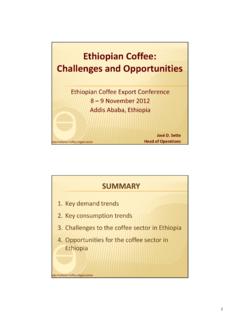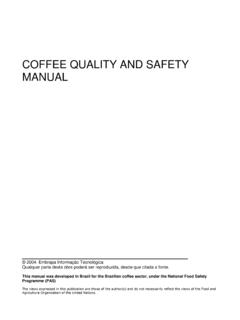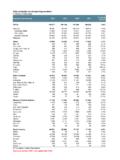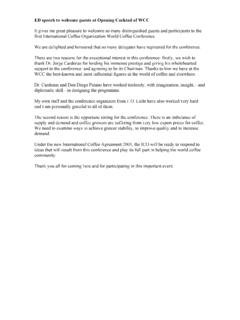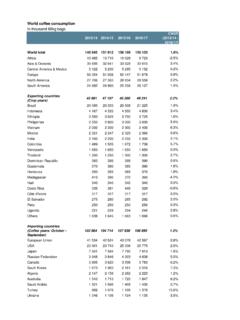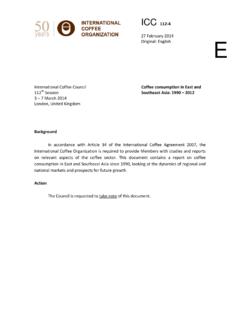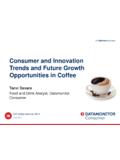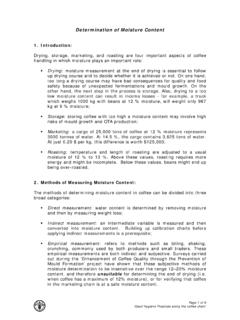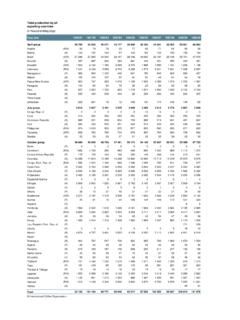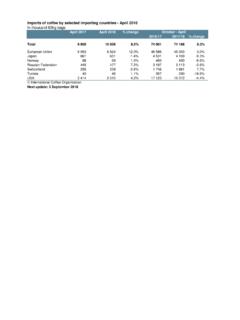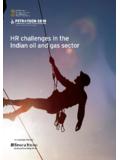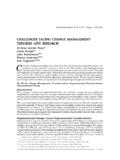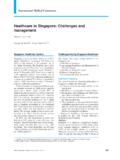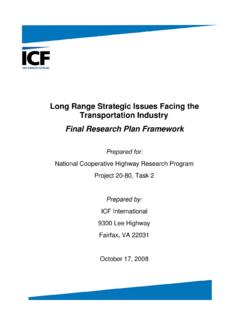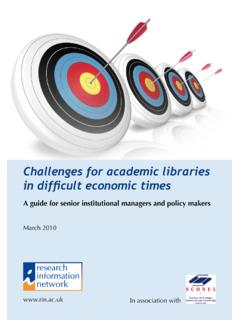Transcription of ICC 111-5 Rev. 1 E - International Coffee Organization
1 International Coffee Council 112th Session 3 7 March 2014 London, United Kingdom World Coffee trade (1963 2013): A review of the markets, challenges and opportunities facing the sector Background After 50 years in existence, the Organization is well placed to provide an overview of the dynamics of the world Coffee market and its prospects for the future. In particular, its adaptation to a changing environment characterized by new challenges such as climate change, risk management in response to price volatility, the growing cost of inputs, the sustainability of the sector, and the development of world consumption.
2 In this study, the first part focusses on Coffee market developments, particularly in terms of fundamentals and prices, during the last 50 years. Part two looks at the current challenges and opportunities for the Coffee market, with a particular focus on the three pillars of sustainability: economic, social and environmental. Action The Council is requested to take note of this document. ICC 111-5 Rev. 1 24 February 2014 Original: French E WORLD Coffee TRADE (1963 2013): A REVIEW OF THE MARKETS, challenges AND OPPORTUNITIES facing THE SECTOR TABLE OF CONTENTS Introduction.
3 2 Section I: Coffee market developments (1963 2013) .. 2 i. Prices .. 2 ii. Production .. 4 Africa .. 5 Asia and Oceania .. 5 Central America and Mexico .. 6 South America .. 7 iii. International trade .. 9 Exports .. 9 Re-exports .. 10 Coffee value chain .. 11 iv. Consumption .. 12 Domestic consumption in exporting countries .. 13 Consumption in traditional importing markets .. 13 Consumption in emerging 13 v. Relationship between fundamentals and prices .. 14 Section II: challenges and prospects for a sustainable Coffee 16 i. Economic 16 Price risk management techniques .. 16 Costs of production .. 17 ii. Social sustainability .. 19 Certification: advantages, costs and challenges .
4 19 iii. Environmental sustainability .. 20 Coffee production and deforestation .. 21 Coffee production and soil degradation .. 21 Coffee production and water and air pollution .. 21 Encouragement of good agricultural practices .. 21 Conclusions: Outlook for the world Coffee sector .. 23 Annex: Methodology used to estimate the total value of the Coffee industry .. 26 WORLD Coffee TRADE (1963 2013): A REVIEW OF THE MARKETS, challenges AND OPPORTUNITIES facing THE SECTOR INTRODUCTION 1. The world Coffee market has undergone a significant transformation over the last 50 years. This document is designed to provide an overview of the market trends and developments since the ICO was established in 1963, utilising the broad array of statistical and economic research which has been undertaken in that time period.
5 2. Section I provides a summary of price movements, the dynamics of supply and demand, and developments in International trade. Up until 1989, the Coffee market was regulated by a series of International Coffee Agreements which were intended to manage supply and maintain price stability. This system subsequently collapsed, and since 1990 the Coffee market has been subject to the free market forces of supply and demand. This report compares and contrasts market prospects in the two time periods, and considers how developments in market fundamentals have influenced prices over time. 3. Section II looks at the current challenges and opportunities for the Coffee market, with a particular focus on the three pillars of sustainability: economic, social and environmental.
6 It gives an assessment of the impact of price volatility on Coffee producers, including the use of risk management instruments and managing the various costs of production. It describes and defines the social indicators of sustainability, taking into particular account the human dimension of Coffee production. Finally, it gives a broad overview of one of the most significant threats to sustainable Coffee production the impact of climate change. 4. The report concludes by offering opportunities and prospects for the Coffee industry, in terms of consumption and production, particularly the growing demand from emerging markets and the expansion of niche value markets in traditional consuming countries.
7 5. This study is intended as a macro-economic overview of the global Coffee trade for members of the general public interested in the dynamics of the evolution and key issues affecting the future of the sector. In-depth analysis of the topics introduced in this document can be found in ICO documents on our website at - 2 - SECTION I: Coffee MARKET DEVELOPMENTS (1963 2013) i. Prices 5. The ICO composite indicator price and group indicator prices since 1965 are shown in Figure 1 below. As indicated in the graphs, prices levels during the regulated market period (1965 to 1989) were relatively high since both upward and downward trends were corrected through the application of export quotas.
8 Under this system, export quotas were in effect during the periods between 1963 and September 1972, from October 1980 to February 1986 and from November 1987 to July 1989. Figure 1: World Coffee prices (Monthly averages: 1965 - 2013) 6. The free market period beginning in 1990 had two sub-periods of markedly low price levels: 1989 to 1993 and 1999 to 2004. The latter sub-period recorded the longest period of low prices ever recorded, known as the Coffee crisis, with severe negative consequences on the Coffee economies of exporting countries. Prices recovered strongly after 2004, reaching a 34-year high in mid-2011. However, there has subsequently been a severe deterioration in prices while costs of Coffee production inputs, particularly fertilizers and labour, continue to rise.
9 7. The differential between Arabica and Robusta prices, as shown in Figure 2, was relatively low during the regulated market period, with the annual average of the differential between Other Milds and Robustas at US cents/lb. The highest annual average during this period was US cents/lb recorded in 1986, when Arabicas were in short supply following a drought in Brazil. During the free market period the price differential widened considerably, recording an annual average of US cents/lb. More specifically, the Arabica/Robusta differential rose to US cents/lb in 2011. The arbitrage between the New York and London futures markets was US cents/lb during the regulated period, with a maximum of US cents/lb in 1986.
10 In the free market period, the average differential between New York and London was US cents/lb and the highest was US cents/lb in 2011 0100200300400500600US c e nts/lba. ICO composite indicator priceNominal termsReal terms050100150200250300350400US c e nts/lbb. Group indicator pricesColombian MildsOther MildsBrazi l i an Natural sRobustas- 3 - Figure 2: Price differentials (Monthly averages: 1965 - 2013) Box 1: Price volatility As is the case of many commodities, price volatility is a major concern for stakeholders in the world Coffee market. In exporting countries, volatility is a source of uncertainty in relation to export earnings and tax revenues, as well as instability in producer incomes.
